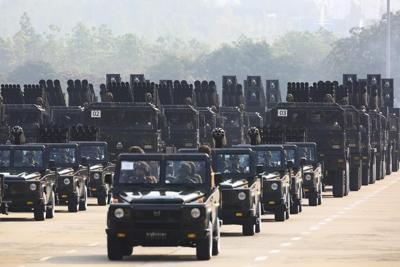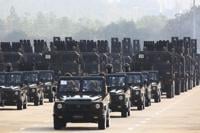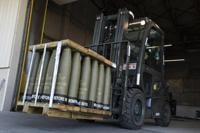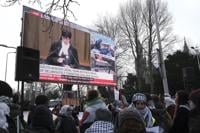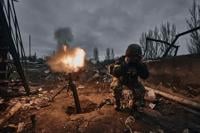UNITED NATIONS (AP) — Myanmar’s military has imported at least $1 billion worth of weapons and related material from Russia, China and other countries since its February 2021 coup, some of which it has used to carry out atrocities against civilians, according to a U.N. report released Wednesday.
The weapons continue to flow to the military despite overwhelming evidence of its responsibility for the atrocities, including some that amount to war crimes and crimes against humanity, said Tom Andrews, the U.N. independent investigator on human rights in Myanmar.
As an example of what he called the junta’s brutality, Andrews pointed to its April 11 airstrike using a Russian Yak-130 fighter jet on a ceremony attended by some 300 opponents of army rule, which was quickly followed by an attack by Russian Mi-35 helicopters on those who came to help. He said at least 160 people were killed, including many children.
In addition, the machine guns and bombs used in the attacks included parts and materials from companies located in Singapore, China and Thailand, he said.
Myanmar is mired in strife because of a political crisis unleashed when the military took power. Its takeover prompted widespread peaceful protests that security forces suppressed with deadly force, triggering armed resistance throughout the country that the army has been unable to quell. Andrews said at least 22,000 political prisoners have been detained since the coup, at least 3.500 civilians have been killed and 1.5 million people have been forcibly displaced.
The report documents over 12,500 purchases that were shipped directly to the Myanmar military or known Myanmar arms dealers working for the military from Feb. 1, 2021, when the military ousted the elected government of Aung San Suu Kyi, until December 2022, Andrews said at a news conference.
He said the volume and diversity of equipment the military received was “staggering,” ranging from fighter jets and attack helicopters and drones to advanced missile systems, tank upgrades, sophisticated communications equipment, radar complexes and components for naval ships.
Andrews, a former Democratic congressman from Maine , said he had received “highly credible and detailed information from confidential sources” identifying the major networks and companies involved in the arms trade with Myanmar.
The report to the Geneva-based Human Rights Council identifies $406 million in weapons and material that went to the Myanmar military from Russia, $267 million from China, $254 million from Singapore, $51 million from India and $28 million from Thailand.
Since the coup, the report said, 28 Russian private and state-owned companies have transferred fighter jets and their spare parts, advanced missile systems, reconnaissance and attack drones, attack helicopters and other systems to the junta.
The report identified 41 private and state-owned companies registered in China and Hong Kong that supplied the Myanmar military with an extensive array of arms, equipment and raw materials between October 2021 and December 2022, including advanced trainer jets, light attack aircraft, tank upgrades and repairs for Chinese fighter jets, which make up the Myanmar Air Force fleet, the report said.
They also supplied aluminum, copper, steel, rubber and lubricants for use in Myanmar’s domestic weapons manufacturing, it said.
Unlike with Russia and China, and to a lesser extent India, Andrews said he received no information indicating that the governments of Singapore or Thailand approved or transferred arms to the Myanmar military.
He said companies in Singapore are of critical importance to the junta, having supplied spare parts, raw materials and manufacturing equipment, especially for Myanmar’s KaPaSa weapons factories. Thai companies have done the same, the report said.
Twelve Thai companies were established after the coup, many by sanctioned arms networks already operating in Singapore, which suggests arms dealers may be looking at Thailand as an alternative route to avoid scrutiny, the report said.
Andrews said Singapore has a policy prohibiting the transfer of arms to Myanmar, and he reported his detailed findings to the government, which he said expressed appreciation for the information and indicated it was reviewing the effectiveness of its export controls.
If the Singapore government stopped all arms shipments to the Myanmar military, he said, the impact on the ability of the junta to manufacture arms “would be significant.”
Andrews said China and Russia both criticized the report, saying it went beyond his human rights mandate, and accused him of “vilifying legitimate arms trade.” He countered that “identifying the sources of gross human rights violations and atrocities, including crimes against humanity and war crimes, is within my mandate and in my moral obligation.”
Andrews said India responded to the report’s findings that 22 state-owned and private firms shipped a coastal surveillance system, a remote-controlled weapons system, components from an ammunition and missile manufacturer, and 122 mm howitzer barrels by saying these involved contracts with the previous civilian government.
A U.N. General Assembly resolution adopted on June 18, 2021, calls upon all member states to prevent the flow of arms into Myanmar, but unlike a Security Council resolution it is not legally binding. The United States, United Kingdom, European Union, Canada and Switzerland have imposed sanctions on arms dealers providing support to the military.
Andrews said the sanctions weren't coordinated and have been largely ineffective. He called for countries to impose coordinated sanctions that target the networks that procure weapons and also the junta's finances.

